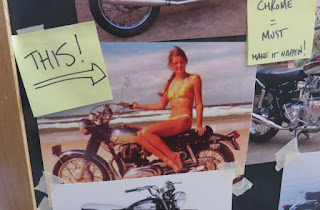 |
| The new Royal Enfield Interceptor 650, with the 1960s original in the background. |
Careful, even cautious design, powered by enormous passion. That was the message Royal Enfield delivered to writers gathered in Santa Cruz, Calif. Sunday for the press launch of the new Royal Enfield 650 twin-cylinder motorcycles.
The Royal Enfield Interceptor 650 and Continental GT 650 are new, modern, capable motorcycles with the style and spirit of the great Royal Enfields of the past, we were told.
 |
| Author and historian Gordon May with an original 1960s Interceptor. |
California had the greatest number of registered motorcycles in America, at the time. It was a hotbed of the youth culture, surfing, hippies, bikers, desert racing. In 1960 Royal Enfield took its powerful but somewhat chubby home-market Constellation, stripped it down, gave it a scrambler look for California.
To Royal Enfield's surprise, the bike sold better with street equipment than without and, in 1962, the company introduced "a proper Interceptor," Gordon said. It was a "road scrambler" and America fell in love with it.
 |
| Fly screen, low bars and hump on the back defined this original 1966 Continental GT. |
They wanted low racing handlebars, a streamlined fly screen, and a hump on the back of the seat to complete the tucked-in look. The first production five-speed gearbox came with the package. This was the bike Britain liked.
 |
| Bulletin board of past high points and possible future looks guided designers of the new bikes. |
Royal Enfield is on track to make not much short of a million motorcycles this year. It plans to make even more next year, with new factories in India and design centers in England and India.
 |
| Yes, THIS. Royal Enfield wanted to recapture spirit of the 1960s. |
And it has been carefully cooked up. We were told that Royal Enfield tested the motor with three different cranks, choosing the one that made the best sound and torque, the brand's signature characteristics.
 |
| Royal Enfield's Mark Wells, center, with clay mock-up of the new Continental GT 650. Wells is Royal Enfield’s Head of Global Product Strategy and Industrial Design. |
"A motorcycle is a personal product," Royal Enfield's Mark Wells told us. "You wrap your body around it."
 |
| Royal Enfield boss Siddhartha Lal tells the press about the laser focus that accompanies laser design: accessibility. |
We haven't yet been told what the new motorcycles will cost. But I liked this statement:
"It's no good making a motorcycle that everybody desires but nobody one can have."
 |
| And not just new motorcycles. Royal Enfield plans to provide the accessories, gear and fashions riders want. |































I wish RE much success with their new Interceptor.
ReplyDeleteTheir next project should be a modernized version of the venerable KX V twin !